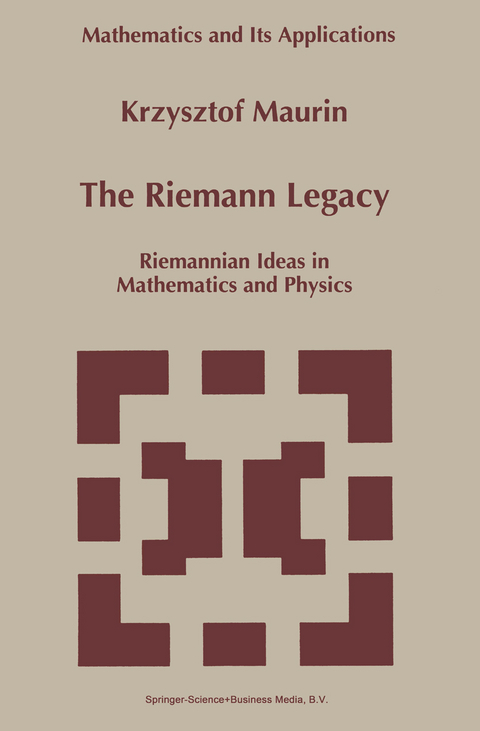
The Riemann Legacy
Springer (Verlag)
978-90-481-4876-9 (ISBN)
I Riemannian Ideas in Mathematics and Physics.- 1 Gauss Inner Curvature of Surfaces.- 2 Sectional Curvature. Spaces of Constant Curvature. Weyl Hypothesis.- 3 Cohomology of Riemann spaces. Theorems of de Rham, Hodge, Kodaira.- 4 Chern—Gauss—Bonnet theorem.- 5 Curvature and Topology or Characteristic Forms of Chern, Pontriagin, and Euler.- 6 Kähler Spaces. Bergman Metrics. Harish-Chandra-Cartan Theorem. Siegel Space (once again!).- II General Structures of Mathematics.- 1 Differentiable Structures. Tangent Spaces. Vector Fields.- 2 Projective (Inverse) Limits of Topological Spaces.- 3 Inductive Limits. Presheaves. Covering Defined by Presheaf.- 4 Algebras. Groups, Tensors, Clifford, Grassmann, and Lie Algebras. Theorems of Bott—Milnor, Wedderburn, and Hurwitz.- 5 Fields and their Extensions.- 6 Galois Theory. Solvable Groups.- 7 Ruler and Compass Constructions. Cyclotomic Fields. Kronecker—Weber Theorem.- 8 Algebraic and Transcendental Elements.- 9 Weyl principle.- 10 Topology of Compact Lie Groups.- 11 Representations of Compact Lie Groups.- 12 Nilpotent, Semimple, and Solvable Lie Algebras.- 13 Reflections, Roots, and Weights. Coxeter and Weyl groups.- 14 Covariant Differentiation. Parallel Transport. Connections.- 15 Remarks on Rich Mathematical Structures of Simple Notions of Physics Based on Example of Analytical Mechanics.- 16 Tangent Bundle TM. Vector, Fiber, Tensor and Tensor Densities, and Associate Bundles.- 17 G-spaces. Group Representations.- 18 Principal and Associated Bundles.- 19 Induced Representations and Associated Bundles.- 20 Vector Bundles and Locally Free Sheaves.- 21 Axiom of Covering Homotopy.- 22 Serre Fibering. General Theory of Connection. Corollaries.- 23 Homology. Cohomology. de Rham Cohomology.- 24 Cohomology of Sheaves. Abstract deRham Theorem.- 25 Homotopy Group ?k(X, x0). Hopf Fibering. Serre Theorem on Exact Sequence of Homotopy Groups of a Fibering.- 26 Various Benefits of Characteristic Classes (Orientability, Spin Structures). Clifford Groups, Spin Group.- 27 Divisors and Line Bundles. Algebraic and Abelian Varieties.- 28 General Abelian Varieties and Theta Function.- 29 Theorems on Algebraic Dependence.- III The Idea of the Riemann Surface.- IV Riemann and Calculus of Variations.- 1 Introduction.- 2 The Plateau Problem.- 3 Teichmüller Theory. Riemann Moduli Problem.- 4 Riemannian Approach to Teichmiiller Theory. Harmonic Maps and Teichmüller Space.- 5 Teichmüller theory and Plateau—Douglas problem.- 6 Rescuing Riemann’s Dirichlet Principle. Potential Theory.- 7 The Royal Road to Calculus of Variations (Constantin Carathéodory).- 8 Symplectic and Contact Geometries. Conservation Laws.- 9 Direct Methods in Calculus of Variations for Manifolds with Isometries. Equivariant Sobolev Theorems. Yamabe Problem and its Relation to General Relativity.- V Riemann and Complex Geometry.- 1 Introduction.- 2 On Complex Analysis in Several Variables.- 3 Ellipticity, Runge Property, and Runge Type Theorems.- 4 Hörmander Method in Complex Analysis.- 5 Wirtinger Theorems. Metric Theory of Analytic Sets.- 6 The Problem of Poincaré and the Cousin Problems.- 7 Ringed Spaces and General Complex Spaces.- 8 Construction of Complex Spaces by Gluing and by Taking Quotient.- 9 Differential Geometry of Holomorphic Vector Bundles over Compact Riemann Surfaces and Kähler manifolds. Stable Vector Bundles, Hermite-Einstein Connections, and their Moduli Spaces.- VI Riemann and Number Theory.- 1 Introduction.- 2 The Riemann ? function.- 3 Hecke Theory.- 4 Dedekind ?K function for number field K and Selberg ?function.- Concluding Remarks.- Suggestions for Further Reading.
| Erscheint lt. Verlag | 6.12.2010 |
|---|---|
| Reihe/Serie | Mathematics and Its Applications ; 417 |
| Zusatzinfo | 3 Illustrations, black and white; XXII, 719 p. 3 illus. |
| Verlagsort | Dordrecht |
| Sprache | englisch |
| Maße | 155 x 235 mm |
| Themenwelt | Mathematik / Informatik ► Mathematik ► Algebra |
| Mathematik / Informatik ► Mathematik ► Analysis | |
| Mathematik / Informatik ► Mathematik ► Angewandte Mathematik | |
| Mathematik / Informatik ► Mathematik ► Geometrie / Topologie | |
| ISBN-10 | 90-481-4876-6 / 9048148766 |
| ISBN-13 | 978-90-481-4876-9 / 9789048148769 |
| Zustand | Neuware |
| Informationen gemäß Produktsicherheitsverordnung (GPSR) | |
| Haben Sie eine Frage zum Produkt? |
aus dem Bereich


